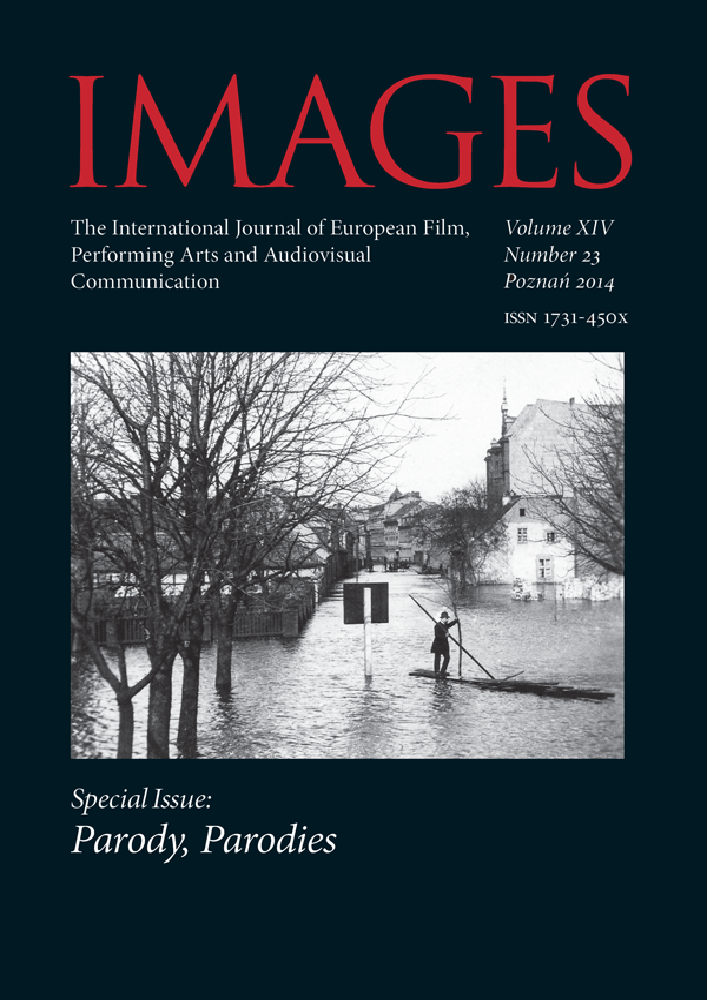Abstrakt
The text is an attempt to analyze the evolution of aesthetic forms and motifs discussed on the example of the so-called “great figure” The Last Supper – the starting point for the analysis of the motif is the photography of David La Chapelle of the series: Jesus is my homeboy. Significant here is the context theory of parody by Linda Hutcheon – understood as a central point overview of contemporary art – a phenomenon combining fidelity to tradition and contemporary ideas of creative freedom, to express, among others, in need of confrontation
with the ‘classic’ conventions – encroaching and deconstructive also in our contemporary pop-cultural processes of “image-consumption”.
Bibliografia
J.J. Wunenburger Filozofia obrazów, przeł. T. Stróżyński, słowo/obraz/terytoria, Gdańsk 2011, s. 11–
L. Hutcheon, Teoria parodii. Lekcja sztuki XX wieku, przeł. A. Wojtanowska, W. Wojtowicz, Oficyna Wydawnicza Atut – Wrocławskie Wydawnictwo Oświatowe, Wrocław 2007, s. 64.
R. Poiriera, The politics of Self-Parody, „Partisan Review” 1968/3
A. Warburg, Narodziny Wenus i inne szkice renesansowe, przeł. R. Kasperowicz, słowo/obraz terytoria, Gdańsk 2010.
K. Pijarski, (Po)nowoczesne losy obrazów, Wydawnictwo PWSFTviT, Łódź 2013.
E. Panofsky, Imago Pietatis. Przyczynek do historii typów przedstawieniowych Mąż Boleści i Maria Pośredniczka, w: idem, Studia z historii sztuki, PIW, Warszawa 1971, s. 91–120.
U. Eco, Lector in fabula, przeł. P. Salwa, PIW, Warszawa 1994, s. 76, 80, 89.
M. Vis & T. Campbell, The Last Supper (2006) [online], <http://www.genericartsolutions.com/Site/Home.html> [dostęp: 2 stycznia 2014 ].
K. Wężyk, Bóg w Ameryce, „Gazeta Wyborcza” (dodatek „Duży Format”) 2013, 28 sierpnia.
Jesus is my homeboy, Robilant & Voena, London 2008
Courtney Love w Heaven to hell, Taschen Books, 2006.
R. Giorgi, El Greco, przeł. H. Borkowska, Klasycy sztuki 18, Rzeczpospolita, Warszawa 2006, s. 28–29.
P. Markiewicz, P. Przybysz, Neuroestetyczne aspekty komunikacji wizualnej i wyobraźni [online], http://www.academia.edu/1378639/Neuroestetyczne_aspekty_komunikacji_wizualnej_i_wyobrazni_wspolautor_Piotr_Markiewicz [dostęp 5 stycznia 2003]
R. Giorgi, El Greco, przeł. H. Borkowska, Klasycy sztuki 18, Rzeczpospolita, Warszawa 2006, s. 28–29.
H. Belting, Antropologia obrazu. Szkice do nauki o obrazie, przeł. M. Bryl, Universitas, Kraków 2007.
E.H. Gombrich, Pełna harmonia, przeł. D. Stefańska-Szewczuk, w: idem, O sztuce, Dom Wydawniczy Rebis, Poznań 2013, s. 297.
Ewangelia św. Marka (Mk 14,18–19). Biblia, Brytyjskie Towarzystwo Biblijne, Warszawa 1975.
C. Chéroux, The Déjà Vu of September 11: An Essay on Intericonicity, „The Social Medium” [online], http://eitherand.org/social-medium/deja-vu-september-11-essay-intericonicity/ [dostęp: 6 stycznia 2014].
http://www.davidlachapelle.com/exhibitions/2013-06-06_galerie-daniel-templon/press/arte-al-limite_1/ [dostęp: 28 grudnia 2013].
Artysta niepokorny, „VU MAG” 2013, 15 października [online], http://vumag.pl/sylwetki/artysta-niepokorny,59734.html [dostęp: 18 grudnia 2013].
J.D. Dillenberger, The religious art of Andy Warhol, Continuum, New York 1998.
http://www.davidlachapelle.com/press
K. Niedałtowski, Zawsze Ostatnia Wieczerza, Wydawnictwo Twój Styl, Warszawa 2006, s. 206.
Ostatnia Wieczerza według Adama Lelko [online], http://www.fotopolis.pl/drukuj.php?n=5682&p=0 [dostęp: 27 grudnia 2013].
www.genericartsolutions.com
www.poland-art.com/index.php/recenzje/633-zuzanna-sokolowska/5980-les-enfants-terribles-polskiej-sztuki-lodz-kaliska-w-muzeum-slaskim
The Hub Magazine „The Last Supper” Spread Interprets the Religious Meal; „TrendHunter” 2011,
maja [online], <http://www.trendhunter.com/trends/hub-magazine-the-last-supper> [dostęp:18 grudnia 2013].
http://www.zazzle.co.uk/peru_cusco_cathedral_last_supper_w_cuy_guinea_pig_laptop_bag-256121716192738676 [dostęp:2 stycznia 2014].
R. Vine, Cracking the Lost Last Supper code, „The Guardian” 2010, 15 stycznia [online],
R. Vine, Cracking the Lost Last Supper code, „The Guardian” 2010, 15 stycznia [online], <http://www.theguardian.com/culture/2010/jan/15/lost-last-supper-the-guidelines>
http://lostpedia.wikia.com/wiki/The_Lost_Supper [dostęp: 27 listopada 2013].
M. Dunea, My Last Supper. 50 Great Chefs and Their Final Meals. Portraits, Interviews, and Recipes (2007–2011).
http://culturepopped.blogspot.com/2007/04/suddenly-last-supper.html [dostęp: 2 stycznia 2014].
M. Sinior, Ostatnia Wieczerza według Adama Lelko, „Fotopolis.pl. Internetowy Magazyn o Fotografii” 2007, 26 marca [online], <http://www.fotopolis.pl/n/5682/ostatnia-wieczerza-wedlug-adama-lelko/>[dostęp: 27 grudnia 2013].
W. Łysiak, Malarstwo Białego Człowieka, t. 4 (rozdz. 38), Wydawnictwo Nobilis, Warszawa 2010.
Licencja
Copyright
© 2014 Uniwersytet im. Adama Mickiewicza w Poznaniu
OPEN ACCESS
